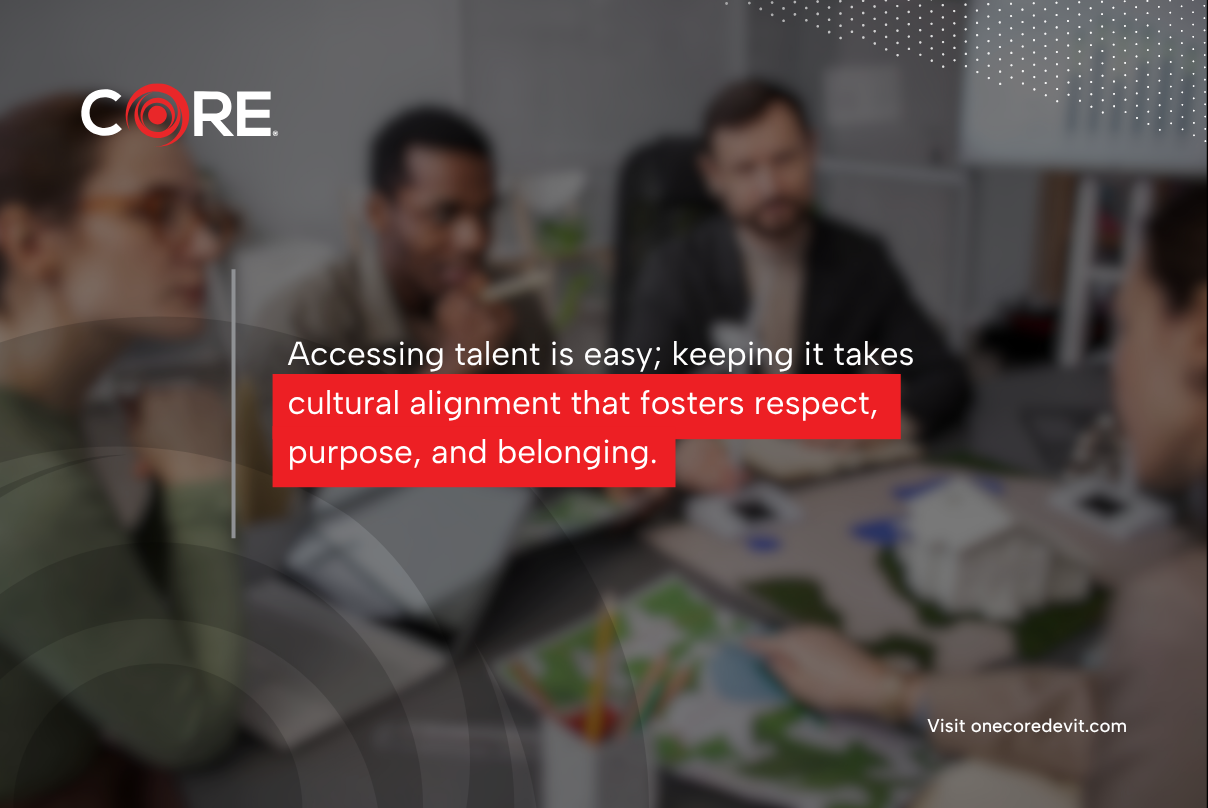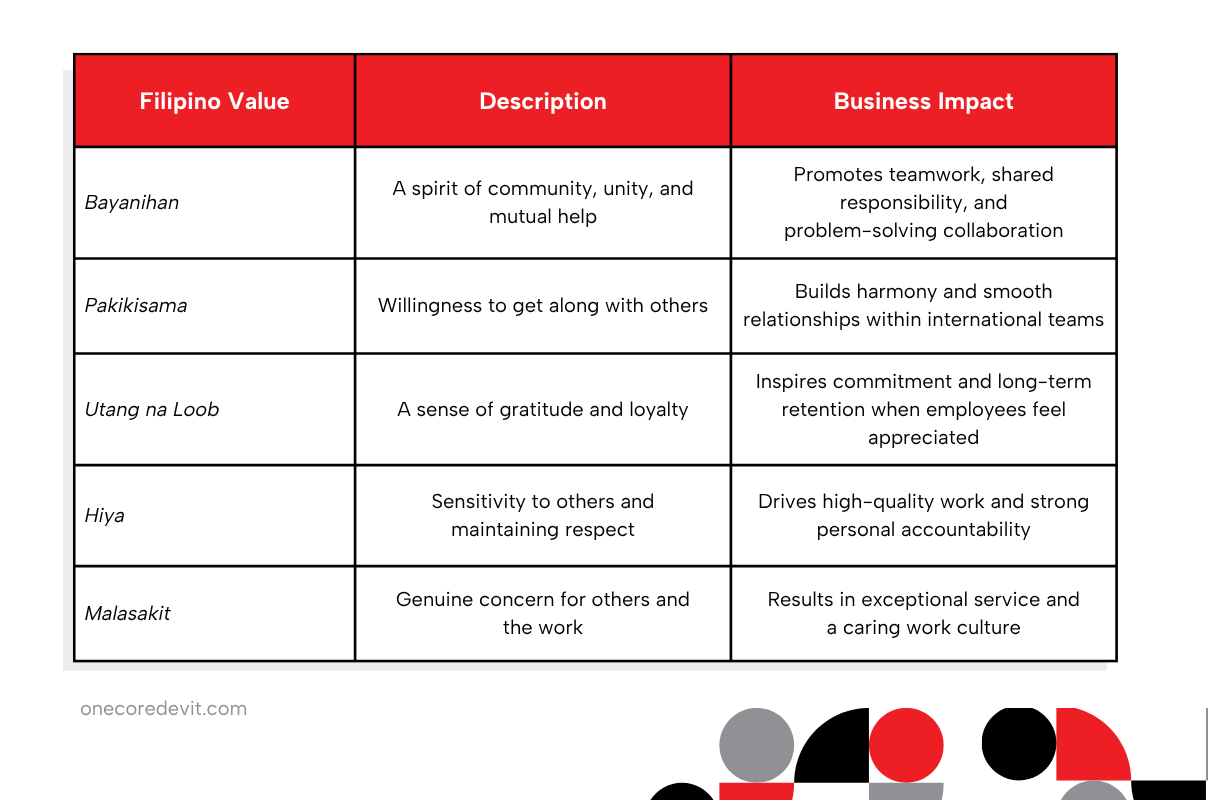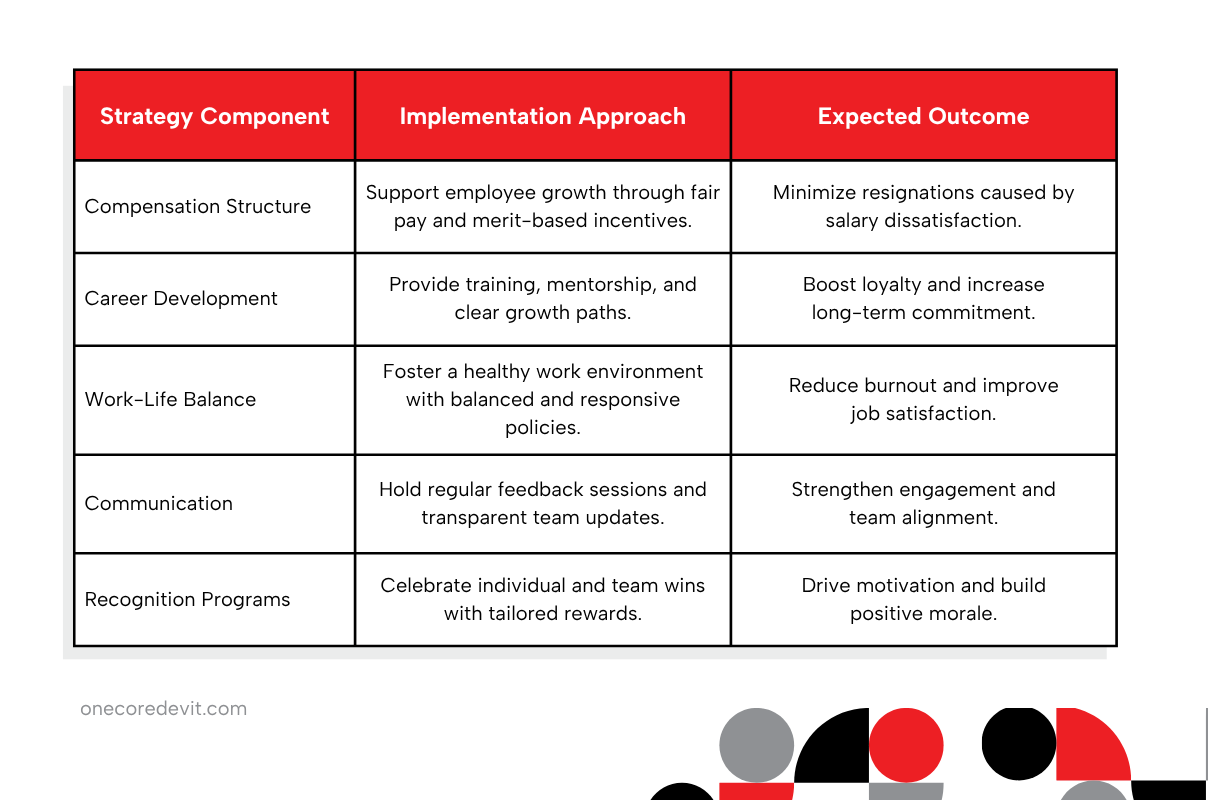Why Cultural Alignment Matters When Going Offshore
Cultural alignment with offshore teams drives success. Organizations with it often see stronger project outcomes and improved team performance. Cross-cultural training can cut project delays by 40%, thanks to better communication and collaboration.
Going offshore means more than hiring talent; it’s about building strong relationships across diverse cultural backgrounds. The success of these relationships often hinges on something many companies overlook: cultural alignment.
Cultural alignment offshore isn’t optional; it’s essential. It shapes trust, teamwork, and efficiency between global teams. This is especially true when partnering with Filipino professionals who value harmony, respect, and loyalty in the workplace. Understanding these values boosts collaboration, engagement, and retention, key ingredients for long-term success. It also minimizes friction and improves productivity across distributed teams.
You’ll discover ways to align with your offshore teams in the Philippines; practical strategies that build connection and drive performance. Apply these insights to improve cultural understanding, strengthen team dynamics, and achieve better business outcomes. Build stronger bridges. Reduce churn. Create teams that consistently deliver results, powered by cultural alignment with offshore teams that share your vision.
What Is Cultural Alignment Offshore and Why Does It Matter?
Cultural alignment offshore means shared values between your company and offshore teams across ethics, communication, and work practices. It ensures both sides understand expectations, reducing friction and boosting collaboration across borders. When teams share aligned values, they build trust, work efficiently, and stay focused on common goals. Without cultural alignment, offshore teams often face miscommunication, frustration, and failure.
Some major benefits when on firm prioritized cultural alignment:
- Productivity boost
- Higher employee retention
- Better client satisfaction
These results prove that cultural alignment offshore isn’t optional. It’s essential for performance and profitability.
The Cost of Cultural Misalignment
Cultural misalignment is one of the leading causes of offshore team failure. When teams operate with different expectations and values, the results can be costly:
- Projects run over budget and behind schedule
- Quality suffers as requirements are misinterpreted
- Employee turnover increases, driving up recruitment costs
- Client relationships deteriorate due to inconsistent service
A study shows how misaligned corporate culture and values can dramatically impact retention. Replacing talent can cost as much as three times the employee’s salary. This creates unnecessary expenses and constant operational disruptions.
Related post: Remote Work Trend Philippines: What US Employers Need to Know in 2025

The Filipino Workforce Advantage: Understanding Cultural Compatibility
The Philippines stands out as a premier offshore destination, with exceptional cultural compatibility with Western businesses. Here’s why:
- Literacy Rate: 97% nationwide
- Global English Proficiency Ranking: 22nd globally
- Cultural Advantages: Deep-rooted Western cultural influences support seamless cross-border collaboration and reduce friction in communication and workflow integration.
Key Filipino Workforce Values That Drive Success
Understanding Filipino values helps you build better relationships with offshore teams and creates smoother alignment with global work expectations. These values support trust, communication, and performance, ensuring cultural alignment with offshore strategies and day-to-day operations.

When leadership aligns with these values, offshore teams feel more connected, supported, and driven to perform at their best. This value-based connection creates stronger engagement, improved performance, and better long-term results for your global business.
Building a Cultural Alignment Framework for Offshore Success
Creating a cultural alignment framework helps structure your offshore integration and sets the stage for long-term collaboration and success. A strong framework focuses on communication, shared values, and expectations, key elements that drive cultural alignment with offshore teams.
Step-by-Step Cultural Alignment Framework
- Assessment: Evaluate your company’s culture and the Filipino work culture. Identify both cultural similarities and potential differences.
- Education: Provide cross-cultural training for both onshore and offshore teams to improve understanding and teamwork.
- Communication: Establish communication protocols that respect cultural norms and ensure information flows clearly between teams.
- Integration: Create regular opportunities for collaboration. Joint planning, shared goals, and team-building help build stronger relationships.
- Measurement: Monitor key indicators like engagement, feedback, and collaboration effectiveness to assess alignment.
- Adaptation: Use insights and feedback to continuously adjust your approach and strengthen cultural alignment with offshore teams.
This cultural alignment framework isn’t a one-time project. It’s a long-term investment that builds resilient, high-performing offshore relationships.
Retention Strategies Offshore: Keeping Your Filipino Team Engaged
Employee retention is a key challenge in offshore setups, especially when working with diverse and distributed global teams. To retain top offshore talent, you must address financial incentives and ensure cultural alignment with offshore teams like those in the Philippines. Filipino professionals value growth, recognition, and a sense of belonging in the workplace.
Here’s a simple but effective framework to keep your Filipino team engaged and committed:
Strategic Framework for Employee Retention

When applying these retention strategies offshore, tailor them to Filipino values for deeper impact and better long-term results. Recognition programs that celebrate teamwork and personal contributions align well with bayanihan (communal unity) and pakikisama (getting along with others) values. Understanding cultural alignment with offshore teams builds stronger relationships, boosts productivity, and improves employee retention across borders.
The Competitive Advantage of Cultural Alignment
Cultural alignment with offshore teams is no longer optional; it’s a key factor for sustainable success. Companies offshoring to the Philippines must understand local values like pakikisama (harmony) and hiya (modesty) to build trust and loyalty. These cultural traits shape how Filipino professionals communicate, collaborate, and thrive in remote or hybrid work environments. When you align with these values, you create stronger team bonds, reduce miscommunication, and increase productivity across time zones. It’s not just about accessing talent; it’s about creating offshore teams that feel connected, respected, and part of your mission.
The most successful companies go beyond hiring; they invest in real relationships and genuine cultural understanding with their offshore teams. They provide cross-cultural training, empower local leadership, and support inclusion across all communication and management processes. This level of commitment leads to higher retention, smoother operations, and stronger engagement from distributed teams. When you prioritize cultural alignment offshore, you set your business up for long-term success; not just in strategy, but in people.
Frequently Asked Questions (FAQs)
Q1: What is cultural alignment and why is it important for offshore teams?
Cultural alignment offshore refers to the harmony between your organization’s values and those of your offshore team. It’s important because aligned teams show higher project success rates, fewer delays, and significantly better retention rates. Without proper alignment, miscommunication and frustration often lead to project failures and high turnover.
Q2: What are the key Filipino workforce values I should understand?
Key Filipino workforce values include Bayanihan (communal unity), Pakikisama (getting along with others), Utang na loob (debt of gratitude), Hiya (sense of propriety), and Malasakit (compassionate concern). Understanding and respecting these values helps build stronger relationships with your Filipino team members and improves overall team performance.
Q3: How can I improve retention rates in my Filipino offshore team?
To improve retention in Filipino offshore teams, implement a comprehensive strategy that includes competitive compensation, clear career development paths, work-life balance initiatives, regular communication, and culturally appropriate recognition programs. Aligning these strategies with Filipino cultural values significantly increases their effectiveness. Regular engagement surveys and exit interviews can help you refine your approach.
Q4: What are the signs of cultural misalignment in offshore teams?
Signs of cultural misalignment include increased miscommunication, missed deadlines, declining work quality, reduced participation in meetings, higher turnover rates, and team conflicts. Early detection of these warning signs allows you to address underlying issues before they escalate into major problems. Regular check-ins and anonymous feedback channels can help identify misalignment early.
Q5: How long does it take to achieve strong cultural alignment with an offshore team?
Achieving strong cultural alignment offshore typically takes 3-6 months of dedicated effort. Initial improvements can be seen within weeks of implementing structured alignment initiatives, but deep alignment develops over time through consistent application of your cultural alignment framework. The process requires ongoing attention rather than being a one-time project.
Q6: What is the cultural alignment theory?
Cultural alignment theory suggests that when a company’s values, communication style, and work practices align with those of its team, especially across borders, it leads to stronger collaboration, trust, and performance. In offshore environments, this alignment helps bridge cultural gaps, reduces misunderstandings, and creates a more cohesive work dynamic.
Q7: Why is knowledge of culture important when manufacturing offshore?
Understanding the local culture in offshore manufacturing helps build better relationships with teams, suppliers, and partners. It reduces miscommunication, improves workflow efficiency, and ensures that management practices are respectful, effective, and motivating within the local context.
When your offshore team shares your values, retention improves and performance soars. Filipino professionals bring heart, adaptability, and commitment; qualities that flourish with the right cultural alignment. CORE® helps you tap into this potential by creating customized solutions built on respect and growth. Our approach ensures your team is aligned, supported, and positioned to thrive. Partner with us today!





